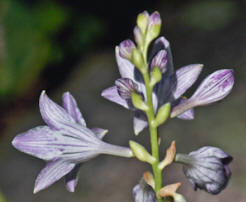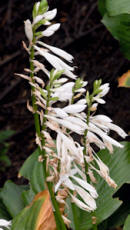
Believe
it or not but many people who grow hostas do not like the
flowers. They cut them off before they have a chance to open.
Wow! To my knowledge, this is the only example of people
removing the flowers from an herbaceous perennial commonly grown
in the landscape.
After years of contemplating this
phenomenon, I have come to the conclusion that it is not the
individual flowers that people do not like. After all, they are
a lily-like bloom which accounts for hostas once being part of
the
Liliaceae Family.
 No, the problem, I suspect is
that, like daylilies (Hemerocallis), the flowers of hostas only
open for one day and then fade. Since they are borne in
groupings or clusters on their scapes, the fading, deteriorating blooms
soon become mixed in with the new blossoms. This can look quite
messy especially on some cultivars. This is what I think people
find objectionable about hosta flowers.
No, the problem, I suspect is
that, like daylilies (Hemerocallis), the flowers of hostas only
open for one day and then fade. Since they are borne in
groupings or clusters on their scapes, the fading, deteriorating blooms
soon become mixed in with the new blossoms. This can look quite
messy especially on some cultivars. This is what I think people
find objectionable about hosta flowers.
Fortunately, 80 to 90% of
hostaphiles like the flowers and that includes Mr. PGC.
Hosta flowers come in a wide array of colors, shapes, sizes,
seasons of bloom, fragrance etc. Although the foliage is still
the king attribute, hosta flowers can add a lot to the home
garden and should be at least a minor factor in cultivar
selection.



